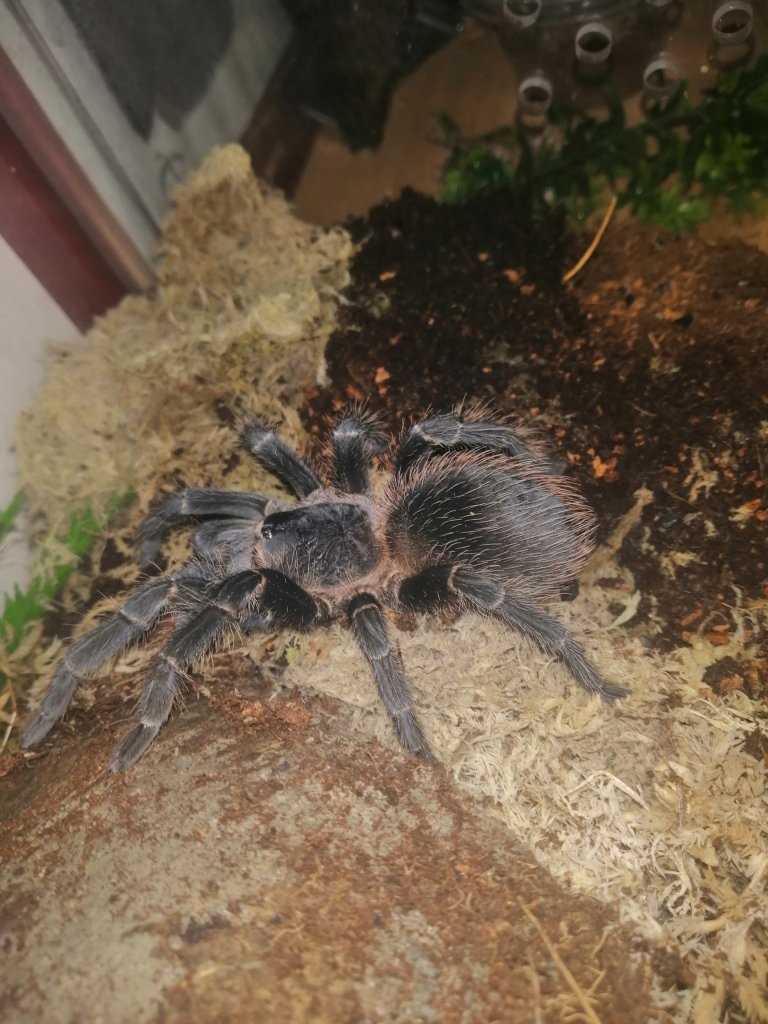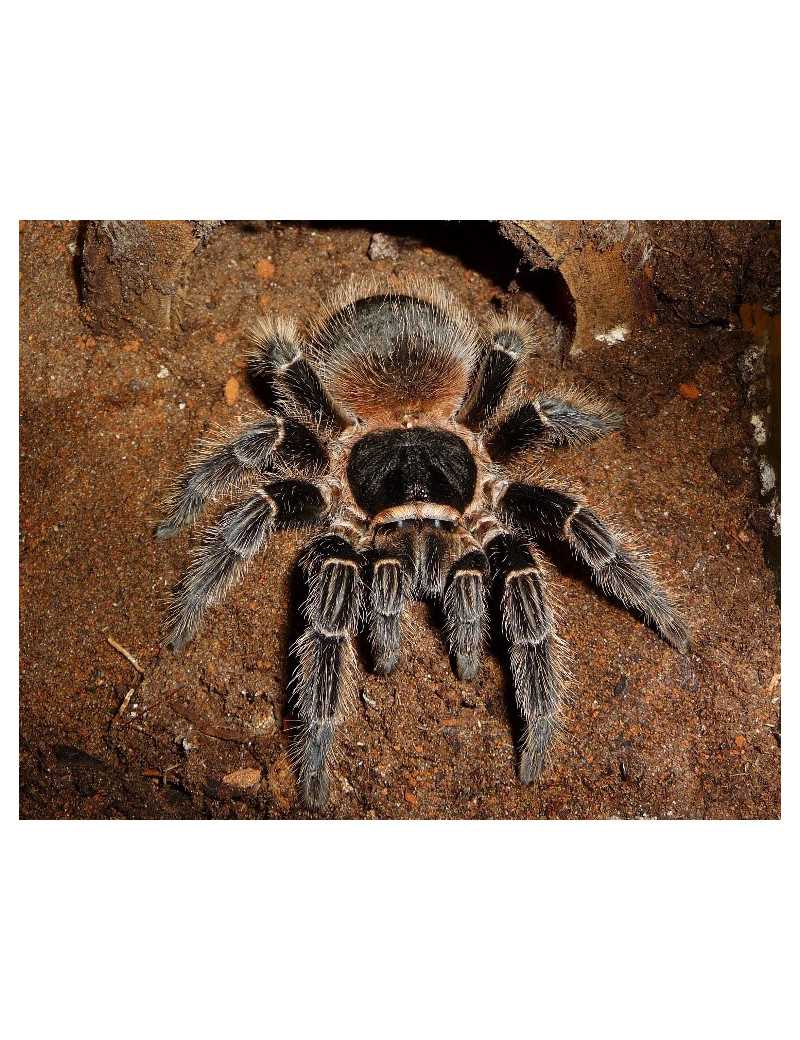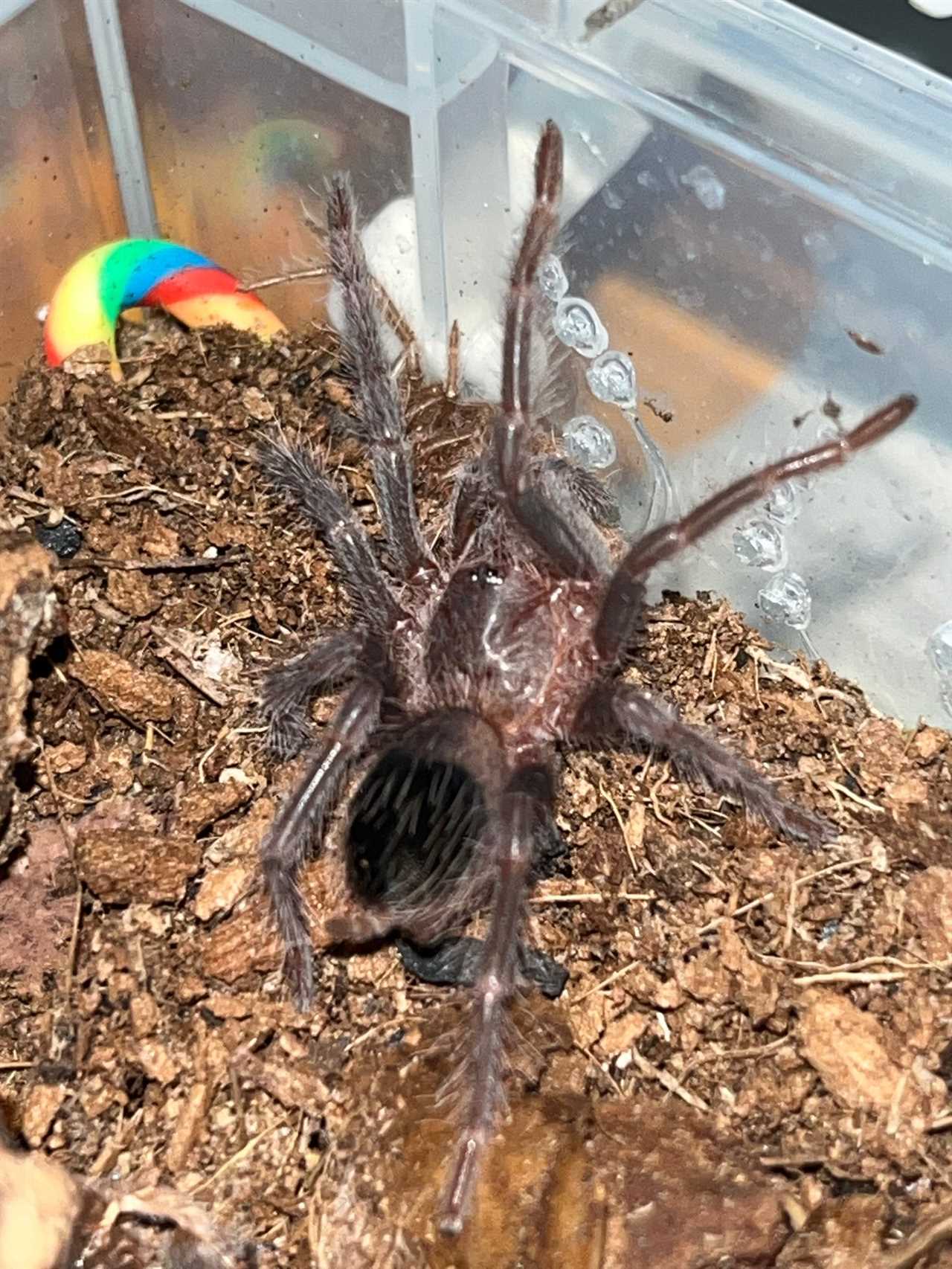Proper care and housing are crucial for the well-being of Lasiodora striatipes. A spacious terrarium, with secure lid and plenty of hiding spots, is essential to recreate their natural environment. The substrate should be kept slightly moist to replicate their humid habitat, and a temperature range of 75-85°F (24-29°C) is ideal. These tarantulas are primarily terrestrial, so providing them with enough space to burrow is crucial for their overall health and well-being.
Physical characteristics of Lasiodora striatipes
This species typically has a robust and heavy body, with males reaching a leg span of up to 8 inches (20 cm) and females growing even larger, with a leg span of around 10 inches (25 cm). The body coloration of Lasiodora striatipes is predominantly black, with distinct white or yellowish bands that run longitudinally along its legs.
The carapace, which is the hard shell covering the spider’s head, is also black and may have some yellowish markings. The abdomen is typically black and adorned with white or yellow bands as well. These contrasting colors serve as a warning to potential predators, signaling the spider’s venomous nature.
Lasiodora striatipes has eight legs, each equipped with sharp claws and covered in tiny hairs that allow it to climb and grip surfaces. Like all tarantulas, this species has fangs that it uses to inject venom into its prey, paralyzing or killing it before consumption.
The lifespan of Lasiodora striatipes can vary, with males typically living for about 3-5 years, while females can live up to 15 years or more. This species is known for its relatively slow growth rate, taking several years to reach maturity.
Key features:
- Robust and heavy body
- Leg span of up to 8 inches (20 cm) in males and 10 inches (25 cm) in females
- Predominantly black coloration with white or yellow bands
- Black carapace with possible yellow markings
- Black abdomen with white or yellow bands
- Eight legs with sharp claws and hairy surface
- Fangs for injecting venom into prey
- Males live for 3-5 years, females can live up to 15 years or more
Overall, Lasiodora striatipes is a visually striking species of tarantula that requires specific care and housing to thrive in captivity. Its unique appearance and relatively long lifespan make it an intriguing pet for those interested in the world of invertebrates.
Natural Habitat of Lasiodora Striatipes
In its natural habitat, Lasiodora striatipes can be found living on the forest floor, burrowed in the ground or in fallen logs. These spiders are adaptable to a wide range of environmental conditions, but they prefer a warm and humid climate.
Terrarium Setup for Lasiodora Striatipes
When keeping Lasiodora striatipes as a pet, it is essential to provide them with suitable housing. A spacious terrarium with a secure lid is recommended to prevent escapes because they are strong and agile climbers.
The enclosure should be large enough to accommodate the spider’s size and behavior. A tank with dimensions of at least 60x40x40 cm is ideal. The bottom of the terrarium should be lined with a substrate such as peat moss or coconut fiber, which mimics the spider’s natural burrow.
Handling Lasiodora striatipes should be approached with caution. While they are generally docile, they possess potent venom and can bite if they feel threatened. It is best to observe and admire them from a distance, rather than trying to handle them. If handling becomes necessary, it is recommended to use a soft paintbrush or similar tool.
Housing requirements for Lasiodora striatipes

Terrarium size
Substrate
The substrate plays a significant role in maintaining the proper humidity levels within the tank. A mixture of organic soil, coco fiber, and peat moss is commonly used as a substrate for Lasiodora striatipes. This type of substrate retains moisture well and provides a suitable burrowing medium for the spider.
Hideouts and decorations
Providing hiding spots and decorations in the terrarium is important as it allows the tarantula to feel secure and reduces stress. You can use pieces of cork bark, hollow logs, or artificial shelters as hideouts. Including some natural elements such as plants, branches, and rocks can also enhance the aesthetic appeal of the enclosure.
Temperature and humidity
Lasiodora striatipes originates from the tropical rainforests of Brazil, so it requires specific temperature and humidity conditions to thrive. The terrarium should be kept at a temperature between 75-85°F (24-29°C) during the day, with a slight drop to 70-75°F (21-24°C) at night. Maintaining a humidity level of around 70-80% is necessary to prevent the tarantula from becoming dehydrated.
Ventilation
Proper ventilation is crucial to prevent the buildup of stale air and excess humidity in the terrarium. Make sure to provide adequate airflow by using a well-ventilated lid or mesh screen on top of the enclosure. This will help maintain a healthy environment for your Lasiodora striatipes.
By following these housing requirements, you can create a suitable and comfortable home for your Brazilian striped-knee tarantula. Providing the right conditions will ensure the well-being and longevity of your pet spider.
Temperature and humidity needs of Lasiodora striatipes
In terms of humidity, Lasiodora striatipes requires a humid environment similar to its natural habitat. The humidity level in the terrarium should be kept between 70-80%. This can be achieved by misting the enclosure with water regularly, or by using a humidifier or fogger.
| Temperature: | Humidity: |
|---|---|
| 75-85°F (24-29°C) | 70-80% |
If the temperature or humidity levels are too low, it can negatively impact the health of your spider, leading to issues such as dehydration or respiratory problems. On the other hand, if the temperature or humidity levels are too high, it can create a breeding ground for bacteria and fungi, which can also be harmful to your pet.
Feeding Lasiodora striatipes
Feeding Lasiodora striatipes is relatively easy and straightforward. As a pet tarantula, Lasiodora striatipes is a carnivorous arachnid and primarily feeds on insects. In captivity, the most common food for Lasiodora striatipes is crickets or roaches. These can be easily purchased from pet stores, or you can breed them at home.
To feed your Lasiodora striatipes, simply place the prey item into its terrarium. The tarantula will quickly detect the presence of the prey and will actively hunt it down. It is fascinating to watch the hunting behavior of Lasiodora striatipes, as it will use its strong fangs and venom to immobilize and kill its prey. Once the prey is subdued, the tarantula will begin to consume it.
Overall, feeding Lasiodora striatipes is an exciting and essential part of caring for this fascinating Brazilian spider. By providing a varied diet and ensuring access to fresh water, you can help keep your Lasiodora striatipes healthy and thriving in its terrarium.
Handling Lasiodora striatipes

Before attempting to handle your Lasiodora striatipes, it’s crucial to ensure that you have a suitable terrarium for the spider. The terrarium should have plenty of hiding spots, a secure lid to prevent escape, and appropriate temperature and humidity levels to mimic its natural habitat. It’s also essential to be familiar with the spider’s behavior and body language, as this can indicate its mood and readiness for handling.
When handling Lasiodora striatipes, it’s recommended to wear gloves or use a proper handling tool such as soft forceps or a paintbrush. These tools provide a barrier between you and the spider and reduce the risk of injury. Gently coax the spider onto your hand or the handling tool, being careful not to startle or squeeze it. Keep movements slow and deliberate to avoid causing stress or panic.
| Handling Tips for Lasiodora striatipes: |
|---|
| 1. Only handle when necessary and infrequently |
| 2. Have a suitable terrarium with hiding spots |
| 3. Wear gloves or use a handling tool |
| 4. Coax the spider gently onto your hand or tool |
| 5. Keep movements slow and deliberate |
| 6. Monitor behavior for signs of distress |
| 7. Provide a calm, secure environment for recovery |
Overall, handling Lasiodora striatipes can be a fascinating experience for tarantula enthusiasts, but it should be approached with care and respect for the spider’s well-being. By following the appropriate handling techniques and providing a suitable environment, you can enjoy your pet Brazilian tarantula while ensuring its health and happiness.
Common health issues in Lasiodora striatipes
1. Molting problems
Lasiodora striatipes, like all arachnids, go through a molting process where they shed their old exoskeleton to grow. Sometimes, they may encounter difficulties during this process, resulting in a partially molted or stuck exoskeleton. If you notice your spider struggling to molt, it is crucial to provide a humid environment to assist in the process. Avoid disturbing or handling the spider during this time, as it can be a delicate and vulnerable period for them.
2. Dehydration
Lasiodora striatipes require a humid environment in their terrarium to thrive. If the humidity levels drop too low, your spider may become dehydrated. To prevent this, regularly mist the enclosure with water to maintain the humidity levels between 70-80%. In addition, provide a shallow water dish to ensure your spider has access to fresh water at all times.
3. Injuries from handling
4. Parasites
Parasites, such as mites, can occasionally infest Lasiodora striatipes. These tiny organisms can cause irritation, stress, and potential health issues for your spider. Regularly inspect your spider for any signs of parasites, such as visible mites or excessive itching and scratching. If you suspect an infestation, consult a veterinarian with experience in arachnid care for appropriate treatment options.
By being proactive in monitoring your Brazilian Lasiodora striatipes’ health and providing proper care, you can help ensure a long and healthy life for your pet spider.
Watching Lasiodora striatipes Behavior
One of the most captivating aspects of Lasiodora striatipes is its hunting and feeding behavior. This spider is an opportunistic predator that will patiently wait for its prey to come within striking distance. It is known to prey upon various insects, such as crickets and cockroaches. When hunting, Lasiodora striatipes will use its strong legs and specialized mouthparts to immobilize and consume its prey.
Furthermore, Lasiodora striatipes is known for its burrowing behavior. In the wild, this spider creates burrows in the ground for shelter and protection. In a terrarium, you may observe your Lasiodora striatipes digging and creating tunnels using its powerful legs and fangs. Providing your spider with a substrate that allows for burrowing, such as a mix of cocofiber and soil, can enhance its natural behavior.
Lasiodora striatipes is a solitary spider, meaning that it prefers to live alone. However, during the breeding season, males will search for females to mate with. Mating behavior in Lasiodora striatipes is also fascinating to observe. The male will perform a courtship dance, displaying its legs and abdomen to the female. If the female is receptive, mating will occur.
Mating and breeding Lasiodora striatipes
After mating, the female Lasiodora striatipes will typically lay an egg sac within a few weeks. These egg sacs can contain hundreds of eggs, and it is crucial to provide the ideal conditions for the eggs to develop successfully. Maintaining stable temperature and humidity levels in the terrarium is essential during this period.
Breeding Lasiodora striatipes can be a challenging endeavor, but with the right knowledge and preparation, it is a rewarding experience. Being able to witness the fascinating behavior of these Brazilian tarantulas and successfully contribute to their life cycle is truly a remarkable feat for any pet arachnid owner.
How long do Brazilian Pet Tarantulas (Lasiodora striatipes) live?
On average, female Lasiodora striatipes can live up to 20 to 25 years when properly cared for, while males have a significantly shorter lifespan of around 5 to 7 years. This difference in lifespan can be attributed to the fact that males typically die shortly after reaching sexual maturity.
Providing proper care and a suitable environment is crucial in ensuring the longevity of your Brazilian Pet Tarantula. These tarantulas require a spacious terrarium with appropriate temperature and humidity levels. A substrate of soil or coconut fiber, along with hiding spots, should be provided to mimic their natural habitat.
Regular observation and monitoring of your Lasiodora striatipes’ behavior and overall health is crucial. Any changes in appetite, activity level, or appearance should be noted and addressed promptly to prevent the development of potential health issues.
Differences between male and female Lasiodora striatipes
Physically, male Lasiodora striatipes tend to be smaller in size compared to females. While females can reach a leg span of up to 7 inches, males usually have a leg span of around 5 inches. Additionally, female Lasiodora striatipes have a more robust and muscular body, while males have a slimmer and more elongated appearance.
One of the most notable differences between male and female Lasiodora striatipes is the presence of a spermatheca in females. The spermatheca is a specialized reproductive organ found in female spiders that allows them to store sperm for an extended period of time. Males, on the other hand, have the presence of palpal bulbs, which are used during mating to transfer sperm to the female.
In terms of behavior, male Lasiodora striatipes are generally more active and tend to wander in search of a potential mate. They often leave their burrows in search of a female’s pheromones, which they can detect using their sensitive legs and pedipalps. Females, on the other hand, are more sedentary and tend to stay within their burrows, waiting for a male to approach.
Brazilian Tarantulas: Lasiodora Striatipes and Its Relatives
Lasiodora Striatipes is a docile and generally calm tarantula species, which makes it a popular choice for beginner pet owners or those who are new to keeping spiders. They are also known for their longevity, with females living up to 20 years or more in captivity.
Aside from Lasiodora Striatipes, the family Theraphosidae includes many other fascinating tarantula species. Some of these relatives include:
These are just a few examples of the diverse and fascinating tarantulas that are related to Lasiodora Striatipes. Each species has its own unique characteristics and care requirements, making them a captivating subject for arachnid enthusiasts.
Whether you are a tarantula enthusiast or simply interested in learning about these remarkable spiders, Lasiodora Striatipes and its relatives offer a captivating insight into the world of arachnids.
Fun Facts about Lasiodora striatipes
1. Striking Appearance

Lasiodora striatipes is named for its distinctive striped knees, which are typically black and white in color. These prominent stripes are often used as a visual display during courtship and territorial displays.
2. Size and Weight
Adult female Lasiodora striatipes spiders can reach an impressive size, with a leg span of up to 8 inches (20 centimeters) and a weight of around 1 ounce (28 grams). Males are smaller, typically reaching a leg span of 5-6 inches (12-15 centimeters).
3. Diurnal Behavior
Unlike many other tarantula species, Lasiodora striatipes is diurnal, meaning it is most active during the day. This makes it a particularly interesting pet to observe, as you can watch its behaviors and interactions in daylight hours.
4. Unique Defense Mechanisms
Lasiodora striatipes has several defense mechanisms to protect itself from predators. When threatened, it may lift its front legs and display its brightly colored abdomen as a warning. It can also kick urticating hairs from its abdomen, which can cause irritation and discomfort if they come into contact with the eyes or skin.
5. Feeding Habits
This tarantula species is an opportunistic feeder and will consume a variety of prey, including insects, small vertebrates, and other invertebrates. They have a fast metabolism and may require regular feeding to maintain their health and energy levels.
6. Lifespan
Lasiodora striatipes has a relatively long lifespan compared to some other tarantula species. Females can live up to 20 years, while males have a shorter lifespan of around 5-7 years.
7. Natural Habitat
8. Popular Pet
Due to their striking appearance and relatively low maintenance requirements, Lasiodora striatipes is a popular choice among tarantula enthusiasts. They can be kept in a spacious terrarium with a substrate that allows for burrowing, and provided with a suitable temperature and humidity range.
9. Breeding Challenges
Breeding Lasiodora striatipes can be challenging, as males have a shorter lifespan and may need to be matured quickly to ensure successful mating. Additionally, cannibalism is a risk during the breeding process, so careful monitoring and separation of individuals may be necessary.
10. Conservation Status
Lasiodora striatipes is not currently considered to be a species of conservation concern. However, habitat loss due to deforestation and collection for the pet trade are potential threats to wild populations.
Conclusion

I’m Lena Adams—a product of an unconventional upbringing in the African wilderness. My father, a daring explorer of African wildlife, sparked my fascination with reptiles, a passion that intertwined with the tragic loss of my mother during an expedition, leaving an indelible mark on my life. Driven to understand the creatures that captivated my parents, I embarked on my journey, sharing insights about reptiles, frogs, and lizards on my website. Through my explorations and conservation efforts, I honour my family’s legacy while seeking connections—to the creatures, nature, and the mother whose presence I yearn to understand.
